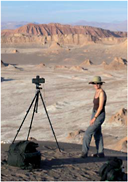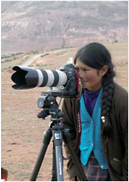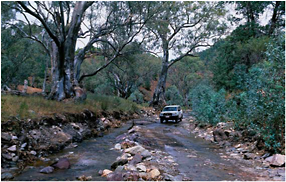
Rainbow over St Michael’s Mount, Cornwall, England (David Noton/National Trust)
The panoramic camera is low tech and basic, the complete opposite of the state of the art Canon.
• Fuji GX617, 90mm lens
Digital v Film
In March 2005, I had a mid-life crisis. I terminated a long-term relationship with my Nikons, switched to digital, and ran off with a younger camera system. Like all such momentous changes it was traumatic and expensive, but it had to be done. Now, several years later I’m ruminating over the changes, weighing up the pros and cons. What do I love about my new life? Freedom, flexibility, quality. What do I hate? The fact that I now feel wedded to a computer. Still, in all honesty, I’ve got no regrets – the timing was right.
The big debate
I’m looking back at a magazine article I wrote five years ago, when the debate between film and digital was in full flow. The digital revolution was perhaps the biggest seismic shift in photography since the evolution of the negative. Pixels were replacing the light-sensitive emulsion, and photographers were wondering if and when to make the change, and how it would affect them. Back then I decided to stick with film over issues such as power, quality, and compatibility with my existing system. If it works, don’t fix it was my ethos. But things moved on quickly and just a year later I couldn’t ignore the fact that the latest generation of digital SLRs were producing images of superior quality to my 35mm film cameras. A jump in available quality was enticing, not to mention all the other advantages of working digitally. There was, though, a big problem for me and many other Nikon users delaying my decision: sensor size. Nikon’s DSLRs use a halfframe sensor, suitable for press work maybe, but not my game. For a fullframe sensor I’d have to switch to Canon and change my entire system. This was a painful decision to make, but the writing was on the wall.
Now the debate has moved on, shooting digitally is the norm and most photographers have a foot at least partially in the pixel camp. I have to admit I’m a convert. The digital revolution has rung the death knell for 35mm film; the quality and versatility available from most DSLRs is far superior. As for medium format it’s a tougher call. I’ve done comparisons between my Canon and a Mamiya RZ67 and not only is the DSLR way more flexible and portable, it delivers superior image quality. Surprised? So was I, but the EOS-1Ds MKII produces a crisper image. The ability to vary the ISO setting to suit the conditions is so useful, not to mention a digital camera’s

Mrs Wendy Noton on location in the Atacama Desert, Chile

Marina, a Quechua shepherd girl, Peru
flexibility when dealing with mixed lighting. Before the change, among a throng of swirling dancers in a village hall on the Tibetan plateau, Wendy was making images with her digital compact that I couldn’t – that said it all.
“The digital revolution has rung the death knell for 35mm film; the quality and versatility available from most DSLRs is far superior”
A personal choice
Still, many will disagree with me, and let’s never lose sight of the fact that it’s the pictures that matter. Ultimately in this big debate intangibles creep in. A photographer friend of mine insists he prefers the feel of film, he doesn’t like ‘metallic’ digital images, and another questions their evenness of tone. These are issues that are impossible to quantify. Ask ten different photographers their feelings about a particular film and you’ll get ten different opinions. I know what I think though: that’s all nonsense. Using those two crucial tools wisely, the Curves and Levels controls at the RAW conversion and Photoshop stages, I have far, far more control over all aspects of my images than I ever have done. Each to their own, but I think the flexibility offered by a DSLR system is a priceless asset that translates into better pictures.

Outback driving off the beaten track in the Flinders Ranges, South Australia
Maintaining discipline
Conversely, shooting digitally can foster a looser approach, a more laissez-faire attitude; blast away and sort it out later, if you shoot enough one is bound to work. In fact, I think to get the best from my DSLR I need to be even more meticulous behind the camera, but undoubtedly the flexibility of digital capture allows me to explore more options, to extract more from any photographic opportunity. To avoid that condemning me to endless computer hours I have to hone in on the best. I’d rather produce one great picture than 50 average ones. So, and here’s the rub, the great challenge of the switch to digital has been firstly ensuring a tight, disciplined approach to shooting while making the most of the possibilities opened up by the flexibility of the kit, and secondly learning a whole new way of editing to avoid spending the rest of my life in Photoshop.
And large format? Well you can’t beat a big piece of film, which is why I still use my 617 panoramic monster. That will change eventually when digital alternatives evolve, but for now I think I’ve got the best of both worlds, and I’m revelling in it.
